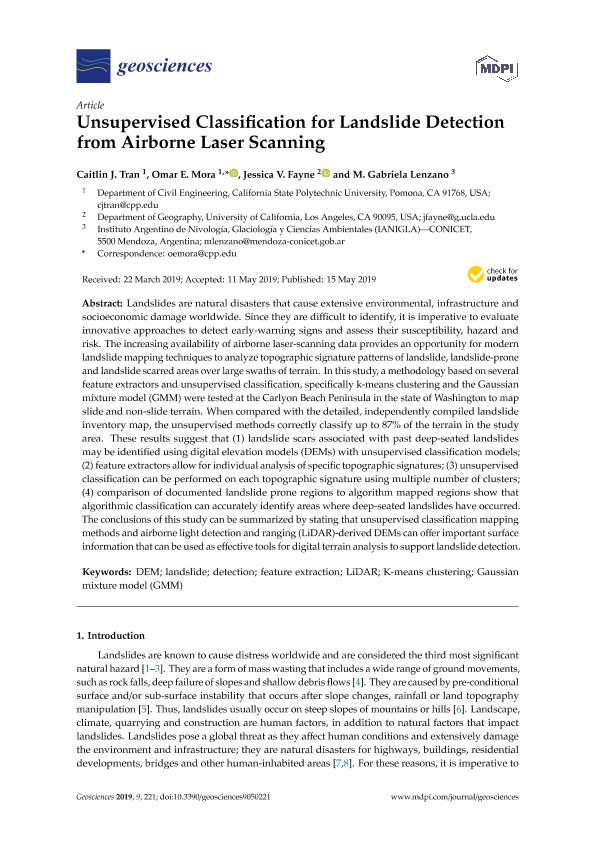Mostrar el registro sencillo del ítem
dc.contributor.author
Tran, Caitlin J.
dc.contributor.author
Mora, Omar E.
dc.contributor.author
Fayne, Jessica V.
dc.contributor.author
Lenzano, María Gabriela

dc.date.available
2020-12-17T15:07:16Z
dc.date.issued
2019-05
dc.identifier.citation
Tran, Caitlin J.; Mora, Omar E.; Fayne, Jessica V.; Lenzano, María Gabriela; Unsupervised classification for landslide detection from airborne laser scanning; MDPI; Geosciences; 9; 5; 5-2019; 1-14
dc.identifier.uri
http://hdl.handle.net/11336/120762
dc.description.abstract
Landslides are natural disasters that cause extensive environmental, infrastructure and socioeconomic damage worldwide. Since they are difficult to identify, it is imperative to evaluate innovative approaches to detect early-warning signs and assess their susceptibility, hazard and risk. The increasing availability of airborne laser-scanning data provides an opportunity for modern landslide mapping techniques to analyze topographic signature patterns of landslide, landslide-prone and landslide scarred areas over large swaths of terrain. In this study, a methodology based on several feature extractors and unsupervised classification, specifically k-means clustering and the Gaussian mixture model (GMM) were tested at the Carlyon Beach Peninsula in the state of Washington to map slide and non-slide terrain. When compared with the detailed, independently compiled landslide inventory map, the unsupervised methods correctly classify up to 87% of the terrain in the study area. These results suggest that (1) landslide scars associated with past deep-seated landslides may be identified using digital elevation models (DEMs) with unsupervised classification models; (2) feature extractors allow for individual analysis of specific topographic signatures; (3) unsupervised classification can be performed on each topographic signature using multiple number of clusters; (4) comparison of documented landslide prone regions to algorithm mapped regions show that algorithmic classification can accurately identify areas where deep-seated landslides have occurred. The conclusions of this study can be summarized by stating that unsupervised classification mapping methods and airborne light detection and ranging (LiDAR)-derived DEMs can offer important surface information that can be used as effective tools for digital terrain analysis to support landslide detection.
dc.format
application/pdf
dc.language.iso
eng
dc.publisher
MDPI
dc.rights
info:eu-repo/semantics/openAccess
dc.rights.uri
https://creativecommons.org/licenses/by/2.5/ar/
dc.subject
DEM
dc.subject
DETECTION
dc.subject
FEATURE EXTRACTION
dc.subject
GAUSSIAN MIXTURE MODEL (GMM)
dc.subject
K-MEANS CLUSTERING
dc.subject
LANDSLIDE
dc.subject
LIDAR
dc.subject.classification
Otras Ingenierías y Tecnologías

dc.subject.classification
Otras Ingenierías y Tecnologías

dc.subject.classification
INGENIERÍAS Y TECNOLOGÍAS

dc.title
Unsupervised classification for landslide detection from airborne laser scanning
dc.type
info:eu-repo/semantics/article
dc.type
info:ar-repo/semantics/artículo
dc.type
info:eu-repo/semantics/publishedVersion
dc.date.updated
2020-11-20T17:52:47Z
dc.identifier.eissn
2076-3263
dc.journal.volume
9
dc.journal.number
5
dc.journal.pagination
1-14
dc.journal.pais
Suiza

dc.description.fil
Fil: Tran, Caitlin J.. California State Polytechnic University; Estados Unidos
dc.description.fil
Fil: Mora, Omar E.. California State Polytechnic University; Estados Unidos
dc.description.fil
Fil: Fayne, Jessica V.. University of California at Los Angeles; Estados Unidos
dc.description.fil
Fil: Lenzano, María Gabriela. Consejo Nacional de Investigaciones Científicas y Técnicas. Centro Científico Tecnológico Conicet - Mendoza. Instituto Argentino de Nivología, Glaciología y Ciencias Ambientales. Provincia de Mendoza. Instituto Argentino de Nivología, Glaciología y Ciencias Ambientales. Universidad Nacional de Cuyo. Instituto Argentino de Nivología, Glaciología y Ciencias Ambientales; Argentina
dc.journal.title
Geosciences
dc.relation.alternativeid
info:eu-repo/semantics/altIdentifier/url/https://www.mdpi.com/2076-3263/9/5/221
dc.relation.alternativeid
info:eu-repo/semantics/altIdentifier/doi/http://dx.doi.org/10.3390/geosciences9050221
Archivos asociados
